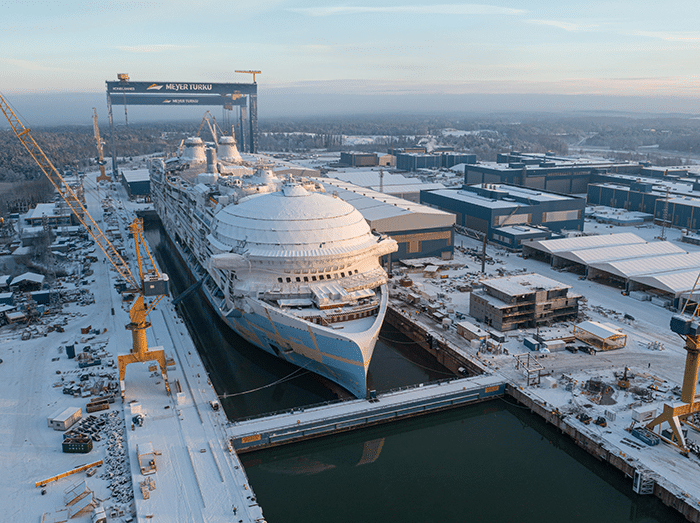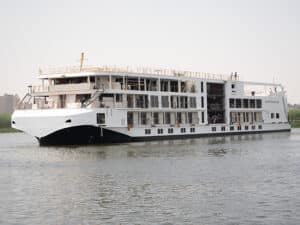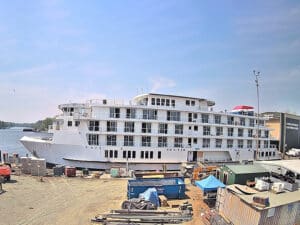
Buoyant bookings boost cruise line hopes
Written by Nick Blenkey
Set to be the next holder of the "world's largest cruise liner," Royal Caribbean International’s Icon of the Seas reached its next major construction milestone at the Meyer Turku shipyard in Turku, Finland, in December when it was floated out of the dry dock and into its outfitting dock. (Credit: Royal Caribbean)
Cruise lines are in the business of pleasing people. They must be. They’re the only shipowners whose cargo can talk back, and not only talk but tweet, yelp, like/dislike and all the rest of that social media stuff. Beyond that, cruises are a consumer product that must be marketed like any other consumer product.
And, while there are other people that cruising has to please, investors and lenders, the signs are that, so far as its customer base is concerned, cruising is crushing it as it returns to near pre-pandemic levels of operation.
The accepted indicator of industry health is how bookings go in the Wave season, the January-March period when cruise lines and travel agents historically book the largest number of cruise cabins for the year ahead — and push out their most attractive deals. This year, all the signs are that the Wave season started earlier and has been a strong one.
“Our guests are now engaging with us to book onboard activities much earlier than in 2019,” Jason Liberty, CEO of Royal Caribbean Cruises Group, told financial analysts in a February 7 conference call. “So far, guests booked on 2023 sailings purchased onboard experiences an average of more than two months earlier than in 2019. This translates into more revenue, stickier bookings, and happy guests.”
Liberty told the analysts that in 2022, “bookings outpaced 2019 levels by a very wide margin throughout the fourth quarter with particularly strong trends during Cyber Weekend. We expected a strong Wave season, but what we are currently experiencing has exceeded all expectations even when considering our capacity growth.”
The bookings strength looks to be industry wide. Carnival Corporation’s Holland America Line brand, for example, says bookings in the third week of January were the highest on record for any January week for the line. The week ending January 20 exceeded bookings during the same week in 2019 by more than 20% while on January 17 alone, Holland America Line reached its highest single-day bookings for any January day on record. Guests were also booking cruises further into the future, with more than 25% of the January 17 bookings being for voyages embarking in 2024.
NEW SHIPS IN THE PIPELINE
The downer in all this is that cruising is emerging from COVID with a massive debt burden on its back — about $33 billion in the case of Carnival Corporation, about $24 billion for Royal Caribbean and about $14 billion for Norwegian.
While we can’t know what the story is on those lines that are not publicly listed, the money to keep them going through the pandemic had to come from somewhere. All this must dampen industry eagerness to take on more debt to place major newbuilding orders. That said, some capacity was squeezed out of the industry during its enforced shut down and cruise lines love new ships because they immediately command big bookings and premium pricing.
In pre-pandemic years, the annual Seatrade Cruise Global event could be banked on to serve as an opportunity for some major new orders to be announced. When this year’s Seatrade Cruise Global takes place in Fort Lauderdale, Fla., March 28 and 29, it’s likely that if any surprise new orders are announced they’ll be at the boutique end and expedition ship end of the spectrum. Meantime, there are a lot of noteworthy new ships in the existing pipeline, which, according to the latest Seatrade count consists of 61 ocean cruise ships due for delivery between 2023 and 2029, with a total of 136,230 lower berths and an order book value of an estimated $40 billion. 19 of these will be LNG fueled.
This year’s new deliveries will include a new holder of the “world’s largest cruise ship” title, Royal Caribbean Cruise Line’s 250,800 gt Icon of the Seas. With a maximum passenger capacity of 7,600 and accommodations for 2,350 crew, it will be RCCL’s first LNG-fueled vessel. Very much down the size scale, with a capacity just 780 passengers, is Silver Nova. The first of Royal Caribbean group luxury brand Silversea Cruises’ Nova class vessels it will feature hydrogen fuel cells as well as LNG fueling.
Icon of the Seas, which is being delivered from the Meyer Turku shipyard in Turkey, comes in at an estimated price of $1.6 billion, which will make it the most expensive cruise ship delivered this year but not the only one in the billion dollar or more category, with MSC Cruises’ 4,816 berth MSC Euribia arriving from Chantiers de l’Atlantique at an estimated $1.06 billion and Carnival Cruise Lines’ 5,400 passenger Carnival Jubilee, from Meyer Werft, Germany also in the billion dollar cost club.
Another new ship joining the world cruise line fleet this year will be the as yet unnamed, 4,000 passenger first ship for Adora Cruises, the Chinese market cruise joint venture between Carnival Corporation, which is currently under construction at the Shanghai Wiagaoqiao shipyard. Whether this spells the start of a threat to the long domination of this sector by European yards means to be seen. Meantime, deliveries all the way through to 2028 are dominated by Fincantieri, with 28 of the 61 vessels, the two Meyer Yards and Chantiers de l’Atlantique.
SHIPS AS WELL AS FLOATING FUN PALACES
Though cruise ships, put cruelly, can be seen as essentially floating resort hotels with theme park touches, underneath all that they are still ships and have to meet all the same environmental regulations as other vessels. Additionally, as cruising is such a public-facing industry it really has to be seen as a good citizen in ESG terms.
LNG fueling has been a statement-making way of demonstrating a commitment to cut CO2 emissions. However, all those cryogenic fuel storage and handling requirements get expensive. LNG’s close relative methanol doesn’t have those requirements.
The giant cruise ship left partially completed in the wake of the collapse of Genting Hong Kong has been acquired by Disney Cruise Line. It will be completed at the MV Werften shipyard in Wismar, Germany, under the management of Meyer Werft, the Papenburg-based company that built the Disney Dream, Disney Fantasy and Disney Wish.
While exterior changes will see the ship carry the iconic, Mickey Mouse-inspired colors of the Disney fleet, complete with signature red funnels, less visible changes will see the 208,000-gross-ton ship become among the first in the cruise industry to be fueled by green methanol.
Meyer Group has set up a new operation, Meyer Wismar, to handle the project.
“When Disney approached us to jointly complete the ship, we saw great opportunities,” says Thomas Weigend, managing director of Meyer Werft and Meyer Wismar. “Meyer stands for innovation, so we are especially happy to deliver a ship that will be among the first in the industry to be powered by methanol. That will require an elaborated transformation of the ship’s engines, additional tanks and many more measures that will make the ship one of the most future-proof. The ship can cruise climate neutral as soon as green methanol is available.”
In another move toward methanol, Costa Group, which operates Carnival Corporation’s Costa Cruises and AIDA Cruises, has signed an MOU with one of the world’s leading methanol producers, Proman.
The MOU aims to push forward the implementation of methanol as a marine fuel by the cruise industry, by enhancing the supply of sustainable methanol, paving the way for the retrofitting of existing vessels to operate on clean fuel, as well as investment in further methanol-fueled newbuilds.
Costa and Proman say that methanol is a cleaner-burning fuel which virtually eliminates airborne pollutants such as particulate matter and sulfur oxides and is widely available and increasingly produced via lower-carbon, biogenic or hydrogen-based pathways. When used in fuel cells, methanol has the potential to allow for lifecycle zero emissions soon.
“The technology to retrofit a vessel to accept methanol as a fuel is available today,” said Tim Cornelius, Proman’s managing director of corporate development. “Our methanol products can facilitate the transition to low carbon intensity fuels. Methanol-powered vessels have a proven track record of reducing and eliminating major greenhouse gas emissions, delivering immediate air quality improvements around major ports and shipping lanes. We are excited to bring our expertise along the full methanol value chain to help deliver on Costa Group’s bold ambitions.”
Underscoring the point that cruise ships have to operate within the same parameters as other oceangoing vessels, Royal Caribbean Group recently named Maersk veteran Palle Laursen as executive vice president, head of marine, effective May 1, 2023. Laursen will report to Royal Caribbean Group’s president and CEO, MaJason Liberty, and will join the company’s executive committee.
With this newly created position, the company will centralize its global and brand marine operations functions under Laursen. He will oversee all marine operations for the company’s entire fleet, as well as strategic oversight of the marine operations of TUI Cruises and Hapag-Lloyd Cruises, in which Royal Caribbean is a 50% joint-venture owner.
Most recently, Laursen served as chief fleet and technical officer at Maersk and was responsible for its entire fleet of more than 750 container vessels, 400 chartered vessels and 350 owned vessels as well as chartering, technical management, crew management, safety and compliance, newbuilding activities and engineering services. He also led Maersk’s effort to have the entire fleet operating fully carbon neutral by 2040.
Having joined the Maersk Group in early 1998, Laursen has spent his entire professional career at the Danish shipping giant. Previously, he was vice president and head of ship management and held several other roles with increasing responsibilities, including head of technical services, ship engineering and technical vessel operations.
“It is with great pleasure that we welcome Palle Laursen to the Royal Caribbean Group,” said Liberty. “Palle has had a long and distinguished career with Maersk and is a recognized leader in the maritime industry. With more than 25 years of experience, his direct technical and operational knowledge will serve our company well, especially as we continually work to decarbonize our business.”



